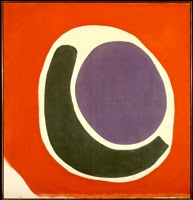Clement Greenberg wasn't an artist, he was a critic. Through the greater part of the 50s and 60s he dominated the New York art world by what some would call despotic methods. Cantankerous and brusque, Greenberg often prided himself on his (what he believed to be) most modern of tastes. In 1961 he published a book titled Art and Culture that recounts his beliefs.
Perhaps aside from the advent of world wars (which are book long discussions in and of themselves) Greenbergian philosophy signals the single greatest shift in the way that artists create since the turn of the century. Abiding by (and reacting against) Greenberg's strict if not tyrannical standards, artists began to recognize the act of painting as equally important to art as its content.
Greenberg believed that the art should be about the medium itself, and rely less on foreign entities to determine its content. Additionally, he believed that any indication of alternative influence was bad for the overall effect of the work. So Greenberg likes abstraction that does not allude to an outside world, he believes in 2 dimensional painting. He believed that anything that looks three dimensional in a painting would be better suited for sculpture. Any story told through the painting, or narrative, would be better left to literature. Therefore the paintings Greenberg endorsed were those that celebrated the act of painting itself in an effort to purify painting.
This philosophy relates to what I discussed in my last blog (which was months ago, sorry!!!) Remember how we examined how Mancini's painterly technique was so drastically different from Bouguereau's? Mancini is less interested in confusing the viewer with what is real and imagined in his painting. The paint is conspicuously there, there's no effort made to allude to photography (photo-realism). Therefore he appreciates the paint itself, it's consistency, the impasto, the texture, its sensuous virtuosity. But Greenberg would have hated both Mancini and Bouguereau's works (though he would have liked Mancini's more) because both contain images of things found in the real world (human figures, atmosphere, landscape, etc.). Greenberg much prefers paintings like the one seen below, Jules Olitski's 1962 painting The Prince Patutsky-Red.
This painting holds some fascinating characteristics that were specifically aimed to making critics like Greenberg happy. The first is the lack of impasto. It almost looks like a water color in person. This is because Olitski used a paint application process called "soak stain painting," a technique invented by another post painterly abstractionist, Helen Frankenthaler. Paint is submerged and diluted in water and then applied to an unprimed canvas, allowing the paint to literally merge with the canvas to become one. This process leaves very little to no impasto and is usually applied through pouring the paint onto the canvas. This makes every painterly technique of the past seem sculptural in even the slightest form of impasto, and remember, Greenberg doesn't like painting and sculpture intermingling.
The form in the Prince Patutsky brings to mind images of the womb, fruit, an olive, an eyeball, something organic found in nature. The shapes are elongated and the colors are almost as ambitious as the scale (92 in x 88 1/4 in). Olitiski goes to great lengths to constantly remind the viewer that they are looking at a painting, not an illusion of reality. Consider how the paint fades away at the bottom segment of the canvas, and left, almost as an ear marker at the bottom left of thepicture. This exposes untouches canvas. Olitski wants you to know he is making a painting that celebrates paint, not an image of something celebrating the thing.
Not many things in contemporary art looks like the Olitski painting, so what happened to change the art world in NY? Pop art next time. yummy
